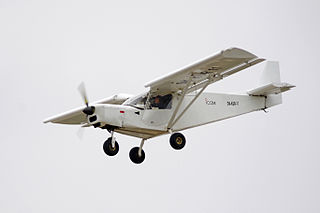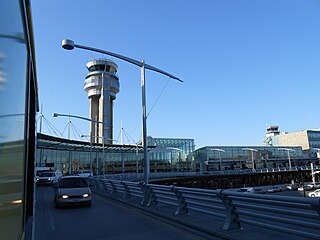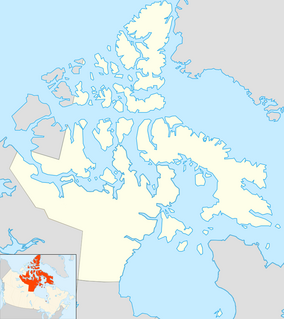
A short takeoff and landing (STOL) aircraft has short runway requirements for takeoff and landing. Many STOL-designed aircraft also feature various arrangements for use on runways with harsh conditions. STOL aircraft, including those used in scheduled passenger airline operations, have also been operated from STOLport airfields which feature short runways.

Greater Moncton Roméo LeBlanc International Airport, or Moncton/Greater Moncton Roméo LeBlanc International Airport is located in the city of Dieppe 4 nautical miles east northeast of downtown Moncton, New Brunswick, Canada. Originally named Greater Moncton International Airport, the airport was renamed in 2016, in honour of former Governor General Roméo LeBlanc.

Montréal–Trudeau International Airport or Montréal–Trudeau, formerly known and still commonly referred to as Montréal–Dorval International Airport, is an international airport in Dorval, Quebec, Canada. It is the primary international airport serving Montreal, 20 km (12 mi) from Downtown Montreal. The airport terminals are located entirely in the suburb of Dorval, while one runway is located in the Montreal borough of Saint-Laurent. Air Canada, the country's flag carrier, also has its corporate headquarters complex on the Saint-Laurent side of the airport. It also serves Greater Montreal and adjacent regions in Quebec and eastern Ontario, as well as the states of Vermont and northern New York in the United States. The airport is named in honour of Pierre Elliott Trudeau, the 15th Prime Minister of Canada and father of current Prime Minister Justin Trudeau.

Montréal–Mirabel International Airport, originally called Montréal International Airport, widely known as Mirabel and branded as YMX International Aerocity of Mirabel, is a cargo and former international passenger airport in Mirabel, Quebec, Canada, 21 nautical miles northwest of Montreal. It opened on October 4, 1975, and the last commercial passenger flight took off on October 31, 2004.

Nordair was a Quebec-based airline in Canada founded in 1947 from the merger of Boreal Airways and Mont Laurier Aviation.

The de Havilland Canada DHC-7, popularly known as the Dash 7, is a turboprop-powered regional airliner with short take-off and landing (STOL) performance. It first flew in 1975 and remained in production until 1988 when the parent company, de Havilland Canada, was purchased by Boeing and was later sold to Bombardier. Bombardier sold the type certificate for the aircraft design to Victoria-based manufacturer Viking Air in 2006.

Ottawa/Macdonald–Cartier International Airport or Macdonald–Cartier International Airport, in Ottawa, Ontario, Canada, is an international airport named after the Canadian statesmen and two of the "founding fathers of Canada", Sir John A. Macdonald and Sir George-Étienne Cartier. Located in the south end of the city, 5.5 nautical miles south of downtown Ottawa, it is Canada's sixth-busiest airport, Ontario's second-busiest airport by airline passenger traffic, and Canada's sixth-busiest by aircraft movements, with 5,110,801 passengers and 150,815 aircraft movements in 2018. The airport was the home base for First Air. The airport is classified as an airport of entry by Nav Canada, and is staffed by the Canada Border Services Agency. The airport is one of eight Canadian airports that have United States border preclearance facilities. The airport used to be a military base known as CFB Ottawa South/CFB Uplands. Although it is no longer a Canadian Forces Base, it is still home to the Royal Canadian Air Force's 412 Transport Squadron, which provides air transport for Canadian and foreign government officials.

Ottawa/Rockcliffe Airport or Rockcliffe Airport,, a former military base, is a non-towered airport located on the south shore of the Ottawa River, 4 nautical miles northeast of Downtown Ottawa, Ontario, Canada. The airport is the home of the Canada Aviation Museum, which owns the field, and is used and maintained by the Rockcliffe Flying Club.

John C. Munro Hamilton International Airport, sometimes known as Toronto Hamilton International Airport, is an international airport in Hamilton, Ontario, Canada. The airport is part of the neighbourhood of Mount Hope, 6 nautical miles southwest of Downtown Hamilton and 64 km (40 mi) southwest of Toronto. The airport serves the city of Hamilton and adjacent areas of Southern Ontario, including the Greater Toronto Area. The airport is considered as a reliever for Toronto Pearson International Airport.

Iqaluit Airport serves Iqaluit, Nunavut, Canada and is located adjacent to the city. It is operated by the government of Nunavut. It hosts scheduled passenger service from Ottawa, Montreal, Rankin Inlet, and Kuujjuaq on carriers such as Canadian North, and from smaller communities throughout eastern Nunavut. It is also used as a forward operating base by the CF-18 Hornet. In 2011, the terminal handled more than 120,000 passengers.

Resolute Bay Airport is located at Resolute, Nunavut, Canada, and is operated by the government of Nunavut. It is one of the northernmost airfields in Canada to receive scheduled passenger airline service.

Ottawa station, or Ottawa Train Station, is the main inter-city train station in Ottawa, Ontario, Canada operated by Via Rail. It is located 4 km to the east of downtown Ottawa in the neighbourhood of Eastway Gardens and serves inter-city trains connecting to Toronto, Kingston, Montreal and Quebec City on Via Rail's Corridor Route.
Quebecair was a Canadian airline that operated from 1947 until 1986. Quebecair was headquartered in Saint-Laurent, Quebec, now a part of Montreal.
Rocky Mountain Airways was an American commuter airline headquartered in Hangar No. 6 of Stapleton International Airport in Denver, Colorado. It was sold to Texas Air Corporation/Continental Airlines in 1986 and was operated as a Continental Express subsidiary until its operations were merged with Britt Airways in 1991. The airline flew from Denver's Stapleton International Airport to a variety of destinations in Colorado, Nebraska and Wyoming. The airline operated out of the old commuter terminal in Concourse A at Stapleton.
A STOLport or STOLPORT was an airport designed with STOL operations in mind, usually for an aircraft class of certain weight and size. The term STOLport did not appear to be in common usage as of 2008 although was commonly used by pilots flying into Biggin Hill during 1986/87 when the London City airport was opened restricting approaches and ceilings to the north of Biggin. A STOLport normally had a short single runway, in general shorter than 1,500 metres (5,000 ft). STOLports only accepted certain types of aircraft, often only smaller propeller aircraft, and often with limits on the amount of fuel that can be taken. In the United States, short runway facilities are simply known as airports and the term STOLport has not been commonly used since the early 1970s.

Metro Airlines, originally Houston Metro Airlines, was a commuter airline that was originally headquartered in Houston, Texas, United States,. Metro subsequently moved its headquarters to north Texas. The airline had an operational base located on the grounds of Dallas-Fort Worth International Airport and also had offices on the airport property and in Grapevine, Texas. Metro evolved into an airline holding company with the acquisition or creation of a number of different airlines, including as the banner carrier operating feeder services for Eastern Airlines as Eastern Metro Express which was based in Atlanta, GA and Metroflight Airlines which operated American Eagle service from the Dallas/Ft. Worth Airport. The company filed for bankruptcy in 1993, and the assets were acquired by AMR Simmons Airlines.
Walt Disney World Airport, also known as Lake Buena Vista Airport and Lake Buena Vista STOLport, is a former small airfield owned by The Walt Disney Company, located within Walt Disney World, just east of the former Walt Disney World Speedway, in Bay Lake in Orange County, Florida, United States. When it was active it accommodated smaller commuter airliners such as the de Havilland Canada DHC-6 Twin Otter turboprop which had STOL capabilities and could operate from airfields with short runways with such airports being known as STOLports. It is no longer registered as an active airport by the FAA, ICAO and IATA and as of December 2017 serves Walt Disney World as a parking and storage lot.

Originally conceived in the 1930s as the main airport for Toronto, the Toronto island airport has long been a source for political debate as to the proper use of its waterfront site in central Toronto. Building the airport necessitated the closure of park lands, a hotel, cottages and an amusement park on the Toronto Island site. Construction of the airport in the late 1930s was stopped and started and its final construction only went ahead after the death of the Toronto mayor who had opposed its construction.
Clear Lake City STOLport was owned by Houston Metro Airlines, a commuter air carrier. It was located adjacent to Clear Lake City on Texas State Highway 3 approximately two miles west of the NASA Johnson Space Center just southeast of Ellington Air Force Base.

Airtransit was a Canadian airline that provided short take-off and landing (STOL) service between Ottawa and Montreal. A subsidiary of Air Canada, the airline operated from 1973-1976 before closing due to poor business.
















